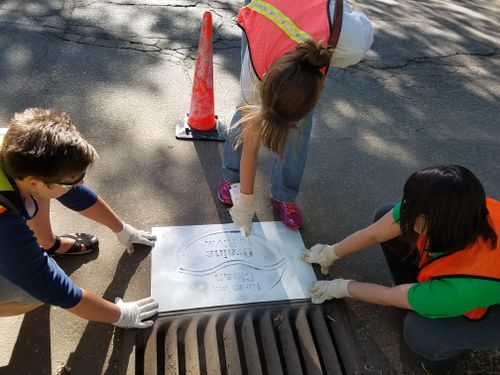
MCM 2 Public Participation/Involvement
Contents
Introduction
Protecting stormwater cannot be completed by one person alone, but will be the result of communities engaging their residents, businesses, and industries to become invested in water quality. Minimum Control Measure (MCM) 2 of the MS4 General Permit requires permittees to find methods to motivate their communities into action through opportunities, programs, or other approaches to prevent stormwater pollution. Common examples seen around Minnesota include storm drain stenciling activities, drain adoption programs, and volunteer monitoring programs.
MS4 General Permit requirements for MCM 2
To keep their community members in the loop, permittees must:
- Provide at least one opportunity for the public to provide input on the stormwater pollution prevention program (SWPPP).
- Provide access to the public to view the SWPPP document, Annual Reports, and other documentation related to the SWPPP.
- Consider public input.
- Document activities, as described here.
Resources
Click on the blue links above in the "MS4 General Permit requirements" section to get more information and resources specific to those permit requirements. In addition, all resources related to MCM 2 are below.
Fact sheets and guidance documents
- EPA MCM 2 guidance - EPA's guidance and suggested BMPs for an effective public involvement program
- EPA's Soak Up the Rain Campaign - Provides template and customizable outreach tools and resources to educate and engage your community on the impacts of stormwater pollution and how to help solve the problem
Documentation and tracking templates
- Documentation of dates and locations of input activities - City of Faribault's tracking template to document dates and locations of events for the annual public opportunity to provide input
- Documentation of dates and locations of input activities - City of Prior Lake's tracking template to document dates and locations of events for the annual public opportunity to provide input
Public Involvement tools and examples
Adopt a storm drain programs
Adopt a storm drain programs engage individual residents to proactively prevent pollution, like leaves and litter, from reaching stormwater. The programs generally allow residents to choose a storm drain they will keep clean. Residents are typically given educational materials when they first sign-up that include tips related to topics such as smart salting, leaf and litter management, or how to spot an illicit discharge.
- Adopt a storm drain program for residents - Example of a storm drain adoption program for residents of St. Paul, Roseville, and Bloomington
- Adopt a storm drain program for residents - Example of a storm drain adoption program for residents of Minneapolis
- Adopt a storm drain program for residents - Example of a storm drain adoption program for residents of Golden Valley
- Adopt a storm drain handout - Adopt-a-Drain's handout to new members explaining why and how to keep storm drains clean
Storm drain stenciling programs
Storm drain stenciling is a way involve groups, such as boy or girl scouts, in your stormwater program while spreading your stormwater message throughout your community. Generally groups identify neighborhoods or specific blocks in your community and spray paint the pavement next to a storm drain with a message about not polluting stormwater.
- Storm drain stenciling fact sheet - MPCA's fact sheet on storm drain stenciling
- Storm drain stenciling guide - University of Minnesota Extension Service's guide to starting a storm drain stenciling program
- Storm drain stenciling guide - Chesapeake Bay Foundation's guide to starting a storm drain stenciling program
- Storm drain stenciling program - Friend's of the Mississippi River's storm drain stenciling program
- Storm drain stenciling program - City of Minneapolis' storm drain stenciling program
Community cleanup events
Community clean up events engage individuals and groups. Clean up events can focus on a specific waterbody, like the City of Brooklyn Center's Shingle Creek event, or on overall stormwater protection, such as Tangletown's leaf raking event.
- Community clean up event - City of Brooklyn Center's clean up event at Shingle Creek
- Community leaf raking event - St. Paul Tangletown neighborhood's community leaf raking event to keep leafs out of the storm drains
